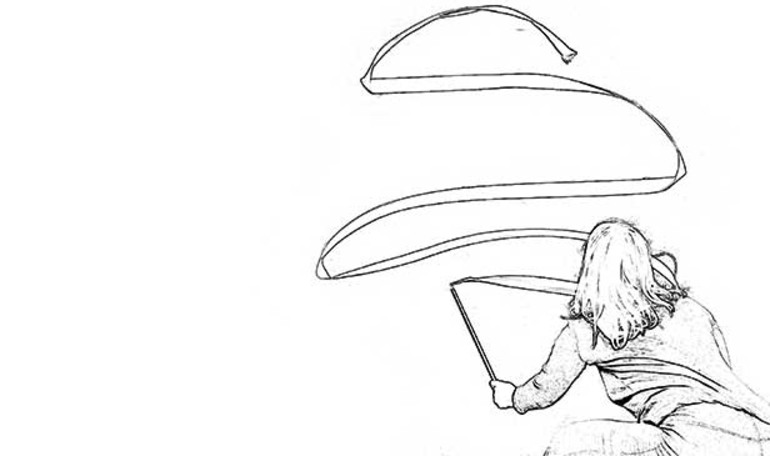
Objects
Most people enjoy using objects, and I often see a twinkle in the students’ eyes while the activities are in progress. I have very often been surprised to see how long they can go on testing different things. Time and time again, I hear them say: ‘This is fun!’ Put scarves in their hands, and ear-training exercises turn into playtime; give each of them a ball, and pulse training becomes an exhilarating change.
Objects in Eurythmics
There is a long tradition of using objects in Eurhythmics classes. Aside from traditional eurhythmics objects like ball, ring, rope, stick, scarf and bean bag, there are many more things that work perfectly, for example stones, chestnuts, matchboxes, elastic bands, kitchen utensils, brooms, twigs, buckets, boots, balloons, rags ... And they can be used in so many different ways. There’s really no limit.
Why use objects?
It is fun to use objects, but there are also many other reasons for using objects:
- Objects make the music visible and concrete
- Objects divert the focus of attention away from yourself
- Objects develop motor skills and kinaesthetic ability
- Objects can serve as a contact link
- Objects stimulate creativity
- Objects can produce sounds
Objects make the music visible and concrete
With objects we can make music visible. You can see the rhythm by bouncing a ball, you can see the melodic line by demonstrating it with a scarf, and you can see the length of the phrase by walking between rings on the floor. By constructing play-mat pathways on the floor you can clearly see the difference between half steps and whole steps in a scale. When music becomes visible, it also becomes more concrete and easier to understand, especially for beginners.
Objects divert the focus of attention away from yourself
When using an object, focus of attention shifts from the person to the object. As a student once said: ‘It isn’t me moving, it’s the object.’ That, I think, puts movement with objects in a nutshell. You concentrate so hard on bouncing the ball, getting air in the scarf, or drawing a long line with a stick, that you forget that you are moving. And the more uncomfortable a student feels about movement, the more reason there is for using objects. When it is the object that will express the music, attention is focused on the object and your body movements for controlling the object are performed almost unwittingly. But even though the movements are not wholly conscious, development takes place. The body harmonizes with the music and becomes a part of the musical expression, which is all part of ‘musicalizing the body’.
Objects develop motor skills and kinaesthetic ability
New movements enter the body when we move with objects. Different kinds of objects inspire different kinds of movement. Test for yourself the difference between moving with a ball and with a scarf, or with a stick as compared with an elastic band. Objects engender different movement qualities, even when you are moving to the same music, and this difference can be deliberately utilized in developing motor skills and kinaesthetic ability. Different kinds of objects give the individual greater kinaesthetic experience and a wider frame of reference, which can affect patterns of movement, posture, and bodily expression. Objects can also work as Gross motor preparation for instrumental playing.
Objects can serve as a contact link
Objects can serve as an impersonal link between two or more students. With objects between them, they can move together without body contact, with their eyes closed or open.
Objects stimulate creativity
Expressing music with objects is good for creativity. The object inspires movement and expression but also imposes certain limits. Testing different possibilities within those limits stimulates creativity.
Objects can produce sounds
Several types of objects can be used for sound production. One can bounce balls, tap with sticks, drum on buckets, listen to hear how many sounds can be made with a matchbox, create rhythms with brooms and much more. For the most part, practicing rhythms with objects is more fun than just clapping your hands. It is also easy to produce sounds with most kinds of objects. You can focus on the music content or the interaction instead of the instrumental technique.
Video
Read more

The European Commission's support for the production of this publication does not constitute an endorsement of the contents, which reflect the views only of the authors, and the Commission cannot be held responsible for any use which may be made of the information contained therein.


